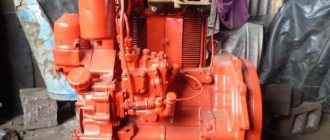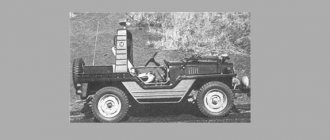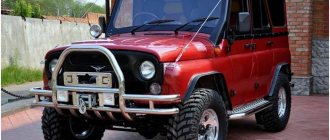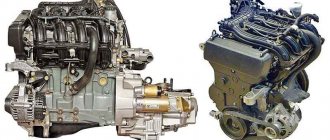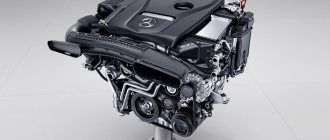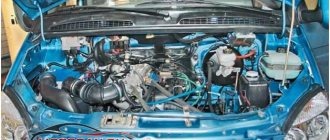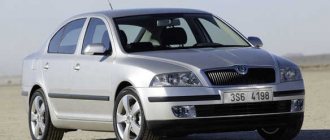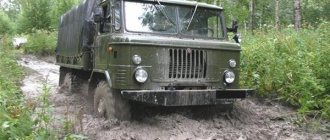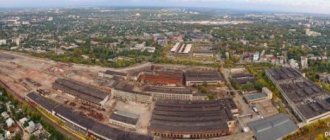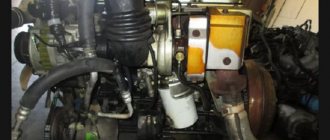GAZ-52
GAZ-52 on Wikimedia Commons
Total information
| Manufacturer: | GAS |
| Years of production: | 1966—1989 |
Design
| Layout: | front-engine, rear-wheel drive |
| Wheel formula: | 4 × 2 |
Engines
GAZ-52
| Brand: | GAZ-52 |
| Type: | Petrol |
| Volume: | 3,485 cm3 |
| Maximum power: | 75 l. s., at 2600 rpm |
| Maximum torque: | 205.9 Nm, at 1400-1600 rpm |
| Configuration: | in-line, 6-cylinder. |
| Cylinders: | 6 |
| Valves: | 12 |
| Cylinder diameter: | 82 mm |
| Piston stroke: | 110 mm |
| Compression ratio: | 6,2-6,7 |
| Supply system: | Carburetor |
| Cooling: | liquid |
| Valve mechanism: | lower valve |
| Cylinder block material: | cast iron |
| Cylinder head material: | aluminum |
| Clock (number of clock cycles): | 4 |
| Cylinder operating order: | 1-5-3-6-2-4 |
| Recommended fuel: | gasoline A-76 |
Transmission
| manual 4-speed | |
| Manufacturer: | GAS |
| Type: | mechanical |
| Number of steps: | 4 |
| Gear ratios: | |
| 1st gear: | 6.48 or 6.4 |
| 2nd gear: | 3,09 |
| 3rd gear: | 1.71 or 1.69 |
| 4th gear: | 1 |
| Reverse gear: | 7.9 or 7.82 |
| Synchronizers: | 3rd and 4th gear |
| Switching: | floor lever |
Characteristics
Dynamic
| Max. speed: | 70 km/h |
On the market
| Predecessor Predecessor GAZ-51 | Successor Successor GAZ-3306 |
| Related: | GAZ-53 |
Other
| Load capacity: | 2500 kg |
| Fuel consumption: | 21 long wheelbase 20 short wheelbase l/100 km. |
| Volume of the tank: | 90 l |
GAZ-52GAZ-52
GAZ-52- Soviet medium-tonnage truck with a carrying capacity of 2.5 tons.
A hybrid model designed with the engine of the most popular Soviet truck GAZ-51 and using components and parts of the GAZ-53 vehicle with a greater payload.
It was produced with modifications at the Gorky Automobile Plant from 1966 to 1989.
However, the GAZ-51 was produced in parallel with the GAZ-52 until 1975.
1,006,330 units of GAZ-52 cars were produced.
Design Features
The GAZ-52 had a cabin from the GAZ-53, which in some cases makes their identification difficult.
Main difference
is an in-line six-cylinder engine developed on the basis of the pre-war carburetor internal combustion engine GAZ-11[1][2], the V-shaped eight-cylinder carburetor engine ZMZ-53 was installed on the GAZ-53.
Also, the GAZ-52 was equipped with wheels and tires from the GAZ-51 measuring 220-508 (7.50-20 inches), rims with six holes. The GAZ-53 was equipped with slightly larger tires - 240-508 (8.25-20 inches), wheels with three holes. Discs are interchangeable.
Over 23 years, the GAZ-52 was produced in several modifications, but two main groups should be distinguished, noticeably different from each other:
Long-wheelbase modifications (1966-1991)
This includes GAZ-52-01 vehicles (chassis for installing vans and tanks, years of manufacture - 1966-1991) and GAZ-52-03 (on-board, load capacity - 2.5 tons, years of production - 1966-1973).
- The wheelbase of these modifications is 3700 mm, exactly the same as on the GAZ-53.
- The frame of these cars is almost the same.
- The rear axle has a detachable main gear housing; axle shaft stockings are pressed into the housing halves, as on the GAZ-51; The main gear is a bevel spiral with a gear ratio of 6.67. The long-wheelbase modification “52-01” of later years of production (presumably after 1978) received a hypoid axle with an integral final drive housing, exactly the same as on the GAZ-53.
- The gearbox with three pairs of helical gears of constant mesh (the gears of the first and reverse gears are straight-cut) had a synchronizer in third and fourth gear. To engage reverse, it was necessary to overcome the additional force of the spring; the lever had two knees.
Short wheelbase modifications
(1966—1989)
The main vehicles were the chassis for GAZ-52-02 dump trucks and the GAZ-52-04 flatbed truck (mass-produced since 1975)
- The wheelbase is 3300 mm, the same as on the GAZ-51.
- The shorter frame was made from spars with a smaller cross-section.
- The rear axle is hypoid, the gear ratio is 6.83.
- The gearbox was from a GAZ-51A, there were no synchronizers, all gears were spur gears. To engage reverse, it was necessary to lift the pawl on the lever; the lever itself had one small bend at the base. Short-wheelbase modifications of the GAZ-52 were also produced with a gearbox with synchronizers in third and fourth gear.
Compared to the GAZ-51, the 52nd and 53rd used improved fastening of the springs to the frame.
- On the GAZ-51 and early short-wheelbase GAZ-52, the main leaves of the springs were bent to form an eye; the spring was attached to the frame through bushings with spring pins, which required constant maintenance and lubrication. The elongation of the spring under load was compensated by an earring. Subsequently, there was unification of the suspension on rubber cushions.
- On the long-wheelbase modifications GAZ-52 and GAZ-53, the upper main sheets were attached to the frame through rubber pads that did not require maintenance; there was no earring. The car's suspension is on longitudinal semi-elliptical springs, with telescopic shock absorbers in the front; rear - with additional spring, without shock absorbers.
Why is it interesting to boost the GAZ 52 engine?
The Gas 52 engine was modified by engineers and ordinary car owners who understood the structure of power units. Many, with the help of engine tuning, brought the Gas 52 to ideal condition. Now he could work for a long time without overheating. Broken country paths, sharp descents and high climbs are no longer scary for the crankshaft.
In general, experienced mechanics say that the engine is quite easy to upgrade yourself in a garage. The advantages of Gas 52 include:
- simple design;
- low price;
- reliability and longevity;
- absence of complex components such as tensioners, balancers, dampers and the like.
It is also easy to assemble and disassemble. Despite many advantages and ease of assembly and disassembly, the engine was considered weak among car owners. Since with all the upgrades it was possible to accelerate to a maximum of 70 kilometers per hour.
Mass production
During serial production, the car was improved:
- The cylinder head designed for M8 spark plugs (M18×1.5 thread) was replaced with a head for A11 spark plugs (M14×1.25 thread); the cylinder head for M8 spark plugs provided a compression ratio of 6.2, and the head for A11 spark plugs increased the compression ratio to 6.7.[3] On engines designed to run on liquefied gas (propane-butane), a cylinder head with a reduced volume of combustion chambers was installed, which made it possible to increase the compression ratio to 7.0. A distinctive feature of such a head was the presence of a cast inscription “76” on its upper surface. “ 76
” denotes the required octane number of gasoline - when installing such a head, the engine required A-76 gasoline, while the standard GAZ-52 engine ran on A-72. - Early GAZ-52 engines had two oil filters - a full-flow coarse filter (with a package of metal plates) and a fine filter DASFO (two-section automobile super-sump filter)
. On later production machines, a single full-flow oil filter was installed (in place of the coarse filter). - On cars of later production, a vacuum booster was installed, included in the hydraulic brake drive system[4][5]
- Also, on cars of later production (usually modifications 52-01) a starter was often installed with an electromagnetic traction relay, powered by the ignition switch; the majority of produced GAZ-52s had a pedal drive for activating the starter on the floor of the cab. When you press the starter pedal, the rod acts on the bendix lever, bringing the gear into engagement with the flywheel ring gear and at the same time closing the contacts of the traction relay, connecting the battery to the starter.
- Over the years, the shape of the radiator trim on the cab has changed. Despite the later improvements of the GAZ-53-12 car, which consisted of the installation of more modern lighting equipment (separate front sidelights PF-130, improved rear lights FP-130), an alarm system and separate hydraulic brakes, etc., these innovations were not applied to the cars GAZ-52, which until the end of production rolled off the assembly line with a single-circuit brake drive and archaic lighting devices from the 1960s, which during operation were often replaced by the owners with more modern ones.
Modifications of GAZ-52
- GAZ-52F (1958-1959) - flatbed truck, base 3.3 m, load capacity 2.5 tons with an in-line six-cylinder pre-chamber-torch engine with a power of 85 hp. pp., a pilot industrial batch was produced;
- GAZ-52G (1959) - flatbed truck, wheelbase 3.7 m, load capacity 4 tons, not mass-produced;
- GAZ-52A (from mid-1964 to 1966) - chassis, wheelbase 3.7 m, load capacity 4 tons;
- GAZ-52P (1959) - truck tractor, wheelbase 3.3 m, not mass-produced;
- GAZ-52Ya (1959) - modification of a flatbed truck with a lifting side, load capacity 2.5 tons, not mass-produced;
- GAZ-52-03 (from June 1966 to 1975) - flatbed truck, wheelbase 3.7 m, load capacity 2.5 tons, engine power 75 hp. With.;
- GAZ-52-01 (from 1966 to 1989) - chassis, wheelbase 3.7 m, load capacity 2.5 tons for buses and specialized vehicles;
- GAZ-52-02 (from June 1966 to 1989) - chassis for GAZ-SAZ dump trucks (SAZ-3503 and SAZ-3504);
- GAZ-52-04 (from April 1975 to 1989) - basic flatbed truck, wheelbase 3.3 m;
- GAZ-52-05 (from April 1975 to 1989) - a cargo taxi based on the 52-04 truck;
- GAZ-52-06 (from 1977 to 1985) - truck tractor, wheelbase 3.3 m;
- GAZ-52-07 (from November 1976 to 1984) - modification 52-04 on liquefied gas, 73 hp engine. s., maximum speed up to 70 km/h;
- GAZ-52-08 (from 1977 to 1989) - modification of the long-wheelbase chassis 52-01 running on liquefied gas, maximum speed up to 70 km/h;
- GAZ-52-09 (from 1977 to 1989) - modification of the 52-05 cargo taxi running on liquefied gas;
- GAZ-52-27 - (from 1984 to 1988) - a compressed natural gas truck with a 65 hp engine. s., maximum speed up to 70 km/h;
- GAZ-52-28 - (from 1984 to 1988) - chassis on compressed natural gas, wheelbase 3.7 m;
- GAZ-52-54 - export tropical modification of GAZ-52-04;
- GAZ-52-74 - export modification of GAZ-52-04;
Technical characteristics of the GAZ 52 engine
From the very beginning, during the production of this engine, the engineers were faced with the task of reducing fuel consumption. Because when the power increased from 70 horses to 90, the power unit simply ate fuel in liters. As a result, the compression ratio in the cylinders was increased, due to which the Gas 52 engine increased power, and in terms of fuel consumption it was no different from the Gas 51 with 70 horses.
The cylinder head has been modernized. With this method, engineers achieved a way to completely burn fuel in the combustion chamber. However, in practice there was a lot of disagreement about this, but the engineers decided not to stop.
The Gas 52 engine operated using prechamber-flare technology. And the volume of the power unit was 3.4 liters. Horsepower was raised to 85 units, and the speed increased to 3000 rpm.
More detailed technical specifications 52 in the table:
| Parameter | Meaning |
| Type of power unit | Carburetor K 126 I |
| Number of cylinders installed in the engine | 6 |
| Number of bars | 4 |
| Valves Location | Bottom |
| Power | 85 horses at 3000 rpm. |
| Compression ratio | 6,7 |
| Torque | 21 kgf/m |
| Tank capacity | 90 l |
| Type of fuel | Petrol |
| Gasoline type | AI 66, 72, 76 |
| Gasoline consumption per 100 km | 20 l |
| Cylinder diameter in mm | 82 |
| Piston stroke in mm | 110 |
| Cylinder block | Cast iron |
| cylinder head | Aluminum |
| Life resource | More than 200,000 km |
Attention! The power unit received new displacers. They were made of aluminum with a high silicon content. The valves were made of steel, which could withstand high temperatures.
Thanks to this engine, the dynamics of the vehicles on which it was installed increased. We practically do not kill the power unit. Experienced drivers and novice trainees of that time knew very well that Gas 52 did not like high speeds.
Similar article Review of the Mercedes M113 engine
Also, everyone knew that the wear of Gas 52 depends on the operating temperature. For example, it was not recommended to operate the motor at engine temperatures above 90 degrees. In winter, they tried to put an insulation cover on the radiator lining.
Dimensions
| Parameter | GAZ-52-03 (long wheelbase) | GAZ-52-04 (short wheelbase) | GAZ-53A |
| Vehicle length, mm | 6395 | 5708 | 6395 |
| Vehicle width, mm | 2380 | 2200 | 2380 |
| Vehicle height, mm | 2190 | 2150 | 2220 |
| Wheelbase, mm | 3700 | 3300 | 3700 |
| Front track width, mm | 1577 | 1650 | 1630 |
| Rear track width, mm | 1650 | 1690 | 1950 |
| Overhang, mm | 866 | 866 | 866 |
| Front overhang angle | 41° | 41° | 41° |
| Rear overhang angle | 24° | 31° | 25° |
| Front ground clearance, mm | 347 | 335 | 347 |
| Rear ground clearance, mm | 265 | 245 | 265 |
| Side platform length, mm | 3740 | 3060 | 3740 |
| Side platform width, mm | 2170 | 2070 | 2170 |
| Side height, mm | 543 | 610 | 680 |
| Loading height, mm | 1280 | 1210 | 1350 |
| Total weight, kg | 5465 | 5170 | 7400 |
In the gaming and souvenir industry
| : Incorrect or missing image | This section is missing references to information sources. Information must be verifiable, otherwise it may be questioned and deleted. You may edit this article to include links to authoritative sources. This mark is set November 5, 2013 . |
K:Wikipedia:Articles without sources (type: not specified)
- Scale models of GAZ-52 and GAZ-53 trucks on a scale of 1:43 are produced in small series by the Ukrainian workshops “Vector-models” and “Kherson-model”.
- In May 2013, a beige model from DIP Models went on sale.
How to maintain the GAZ 52 engine
Every engine requires preventive maintenance once a year. Experienced mechanics do the following when maintaining the Gas 52 unit:
- testing engine components and parts for performance;
- tighten various fastenings of the power unit;
- test the clutch pedal for free play - from 34 mm to 45 mm;
- testing the tightening of the suspension to the engine mounts;
- inspect for engine oil leaks or other leaks and eliminate them;
- check the operation of the power system;
- test the unit components for leaks;
- clean the pipes and change filters and other worn parts;
- check the engine ventilation;
- tighten all elements to the required range with a torque wrench.
Similar article Toyota 2L Diesel Engine
Experienced mechanics advise changing engine oil once every 7 thousand kilometers. Lubricants that are useful for filling include:
- all-season mineral oil AC 8;
- semi-synthetic lubricant from Lukoil.
Attention! Experienced mechanics do not recommend delaying preventative maintenance. Thus, the car owner brings the death of the power unit closer.
Notes
- Alekseenko A.
[www.gaz20.spb.ru/tech_devices_engine.htm Engine]. "Victory". Retrieved January 22, 2010. [www.webcitation.org/68A60q0dx Archived from the original on June 4, 2012]. - Kirindas A
[engine.aviaport.ru/issues/40/page52.html One step forward and two steps back. Selected episodes from the history of the creation of first-generation six-cylinder GAZ automobile engines] // Engine. - 2005. - No. 4 (40). - The USSR stopped producing low-octane gasoline A-66
- On passenger cars, a vacuum booster is used, connected to the main brake cylinder, located under the hood. Due to its large size, the booster on GAZ trucks is placed on the frame behind the cab and is not mechanically connected to the brake pedal and the main brake cylinder.
GAZ-52 - video review
The first pilot batch of GAZ-52 trucks was manufactured back in 1958. The main designer of the model was Alexander Dmitrievich Prosvirnin; Leading designers are Boris Ilyich Shikhov and Vladimir Dmitrievich Zapoinov. Prosvirnin also developed the GAZ-51, then still in the role of an ordinary designer. The new GAZ-52 truck was exhibited not only at VDNKh, but also at foreign car shows. And at the international exhibition in Brussels in 1958, he even received the Grand Prix among trucks. For those times it was a truly progressive, high-tech car.
Initially, it was planned that the cars of this model would be equipped with engines of a completely new advanced design: with a prechamber-torch ignition system. It was an in-line overhead valve 6-cylinder GAZ-51F engine with a power of 80 hp. at 3000 rpm, with a maximum torque of 21.5 kgm at 1600-1800 rpm, a compression ratio of 6.7 and a displacement of 3485 cm3, with a two-chamber K-104 carburetor. Fuel is the same low-octane gasoline “A-66”.
This engine used separate cooling of the cylinder head and block; To increase the wear resistance of the crankshaft, trimetallic main and connecting rod bearing liners with a metal-ceramic sublayer (steel strip, copper-nickel sublayer and antifriction lead alloy SOS-6-6) were introduced instead of bimetallic ones. In addition, dirt traps were introduced on the crankshaft, instead of two oil filters (coarse and fine), one centrifugal one was installed, and instead of the usual single-chamber carburetor, as already noted, a two-chamber carburetor of a new design was used.
In other places, “GAZ-52” was also not just “GAZ-51” with a different cabin.” In particular, the following were installed on the machine:
— new reinforced clutch with an increased diameter of the driven disk and friction linings; — four-speed gearbox with synchronizer in third and fourth gears, — cam differential of the rear axle of limited friction, which improved cross-country ability and stability on bad roads, ice, and off-road conditions; — suspension with the ends of the springs embedded in rubber cushions.
This is what GAZ-52 looked like in the 60s
However, in practice, in direct economic operation, the engine with prechamber-torch ignition showed itself on the negative side. Significant shortcomings of the GAZ-51F engine were identified: difficulties with starting the engine, recurring with annoying regularity; job instability; numerous cases of failure for no apparent reason; excessive difficulty in adjusting the carburetor.
Negative experience in operating GAZ-52F vehicles and unsuccessful attempts to overcome the problems of the new system engine ultimately forced GAZ specialists to abandon this engine. And put the old GAZ-51 engine into the new car. But they worked on it, boosting it to a power of 75 hp, and modernizing it to the best of their ability. It became the main power unit of this model.
The next step was the release of a pre-production batch of GAZ-52 flatbed trucks and the GAZ-52A multifunctional chassis, with a total of 2,400 units. This happened in 1964. At the same time, work was underway to launch mass production of the GAZ-53 model, equipped not with a six-, but with an eight-cylinder V-shaped 115-horsepower ZMZ-53 engine. As a result, the GAZ-53 was put into production a year earlier than the GAZ-52 - in 1965.
In the 70s, the cabin acquired more familiar features. One photo shows GAZ-51, GAZ-52 and ZIL-130 trucks
The 52nd continued to be meticulously tested until June 1966, until the production of the universal GAZ-52A chassis with a wheelbase of 3700 mm was finally put into mass production. This, the first production model of the 52nd, which was assigned, was at first used only for the installation of vans from the Gorky Trade Engineering Plant (GZTM), and was used as a delivery vehicle in trade and related industries. But very little time will pass, and the hardy and unpretentious GAZ-52 can already be found on any collective or state farm. The forced engine from the 51st was given the same index: “GAZ-52-01”.
The GAZ-51A was not discontinued with the advent of new models, but was produced in mass quantities until 1975 inclusive.
Gasoline tanker truck on the GAZ-52-01 chassis
Links
GAZ buses GAZ-03-30 • GAZ-05-193 • GAZ-55 • GZA-651 • “GAZelle” • “GAZelle-Business” • “Sobol” • “GAZelle-Next” GAZ special equipment GAZ-VM • GAZ-46 • Half-track vehicle based on GAZ-63 • GAZ-47 (GT-S) • GAZ-71 (GT-SM) • GAZ-34039 • GAZ-34039 “Irbis” • GAZ-34039K “Irbis” » • GAZ-3409 “Beaver” • GAZ-3344 • GAZ-3351 • “Tiger” • GAZ-3937 • GAZ-5903 (BTR-80) • GAZ-59039 (BMM-80) • GAZ-5903V “Vetluga” • GAZ-5903Zh • GAZ-59402 “Blizzard”
An excerpt characterizing the GAZ-52
“No, now I won’t miss the opportunity, like after Austerlitz,” he thought, expecting every second to meet the sovereign and feeling a rush of blood to his heart at this thought. I will fall at my feet and ask him. He will raise me, listen and thank me.” “I am happy when I can do good, but correcting injustice is the greatest happiness,” Rostov imagined the words that the sovereign would say to him. And he walked past those who were looking at him curiously, onto the porch of the house occupied by the sovereign. From the porch a wide staircase led straight upstairs; to the right a closed door was visible. At the bottom of the stairs there was a door to the lower floor. -Who do you want? - someone asked. “Submit a letter, a request to His Majesty,” said Nikolai with a trembling voice. - Please contact the duty officer, please come here (he was shown the door below). They just won't accept it. Hearing this indifferent voice, Rostov was afraid of what he was doing; the thought of meeting the sovereign at any moment was so tempting and therefore so terrible for him that he was ready to flee, but the chamberlain Fourier, who met him, opened the door to the duty room for him and Rostov entered. A short, plump man of about 30, in white trousers, over the knee boots and one cambric shirt, apparently just put on, stood in this room; the valet was fastening a beautiful new silk-embroidered belt on his back, which for some reason Rostov noticed. This man was talking to someone who was in another room. “Bien faite et la beaute du diable, [Well-built and the beauty of youth," this man said, and when he saw Rostov he stopped talking and frowned. -What do you want? Request?... – Qu'est ce que c'est? [What is this?] - someone asked from another room. “Encore un petitionnaire, [Another petitioner,”] answered the man with the help. - Tell him what's next. It's coming out now, we have to go. - After the day after tomorrow. It’s too late... Rostov turned and wanted to leave, but the man in the arms stopped him. - From whom? Who are you? “From Major Denisov,” Rostov answered. - Who are you? Officer? - Lieutenant, Count Rostov. - What courage! Give it on command. And go, go... - And he began to put on the uniform handed to him by the valet. Rostov went out again into the hallway and noticed that there were already many officers and generals on the porch in full dress uniform, whom he had to pass by. Cursing his courage, frozen by the thought that at any moment he could meet the sovereign and in his presence be disgraced and sent under arrest, fully understanding the indecency of his act and repenting of it, Rostov, with downcast eyes, made his way out of the house, surrounded by a crowd of brilliant retinue , when someone's familiar voice called out to him and someone's hand stopped him. - What are you doing here, father, in a tailcoat? – his bass voice asked. This was a cavalry general who earned the special favor of the sovereign during this campaign, the former head of the division in which Rostov served. Rostov fearfully began to make excuses, but seeing the good-naturedly playful face of the general, he moved to the side and in an excited voice conveyed the whole matter to him, asking him to intercede for Denisov, who was known to the general. The general, after listening to Rostov, seriously shook his head. - It’s a pity, it’s a pity for the fellow; give me a letter. Rostov barely had time to hand over the letter and tell Denisov’s whole business when quick steps with spurs began to sound from the stairs and the general, moving away from him, moved towards the porch. The gentlemen of the sovereign's retinue ran down the stairs and went to the horses. Bereitor Ene, the same one who was in Austerlitz, brought the sovereign's horse, and a light creak of steps was heard on the stairs, which Rostov now recognized. Forgetting the danger of being recognized, Rostov moved with several curious residents to the porch itself and again, after two years, he saw the same features he adored, the same face, the same look, the same gait, the same combination of greatness and meekness... And the feeling of delight and love for the sovereign was resurrected with the same strength in Rostov’s soul. The Emperor in the Preobrazhensky uniform, in white leggings and high boots, with a star that Rostov did not know (it was legion d'honneur) [star of the Legion of Honor] went out onto the porch, holding his hat under his hand and putting on a glove. He stopped, looking around and illuminating everything around him with his gaze. He said a few words to some of the generals. He also recognized the former chief of the division, Rostov, smiled at him and called him over. The entire retinue retreated, and Rostov saw how this general said something to the sovereign for quite a long time. The Emperor said a few words to him and took a step to approach the horse. Again the crowd of the retinue and the crowd of the street in which Rostov was located moved closer to the sovereign. Stopping by the horse and holding the saddle with his hand, the sovereign turned to the cavalry general and spoke loudly, obviously with the desire for everyone to hear him. “I can’t, general, and that’s why I can’t because the law is stronger than me,” said the sovereign and raised his foot in the stirrup. The general bowed his head respectfully, the sovereign sat down and galloped down the street. Rostov, beside himself with delight, ran after him with the crowd. On the square where the sovereign went, a battalion of Preobrazhensky soldiers stood face to face on the right, and a battalion of the French Guard in bearskin hats on the left. While the sovereign was approaching one flank of the battalions, which were on guard duty, another crowd of horsemen jumped up to the opposite flank and ahead of them Rostov recognized Napoleon. It couldn't be anyone else. He rode at a gallop in a small hat, with a St. Andrew's ribbon over his shoulder, in a blue uniform open over a white camisole, on an unusually thoroughbred Arabian gray horse, on a crimson, gold embroidered saddle cloth. Having approached Alexander, he raised his hat and with this movement, Rostov’s cavalry eye could not help but notice that Napoleon was sitting poorly and not firmly on his horse. The battalions shouted: Hurray and Vive l'Empereur! [Long live the Emperor!] Napoleon said something to Alexander. Both emperors dismounted from their horses and took each other's hands. There was an unpleasantly false smile on Napoleon's face. Alexander said something to him with a gentle expression. Rostov, without taking his eyes off, despite the trampling of the horses of the French gendarmes besieging the crowd, followed every move of Emperor Alexander and Bonaparte. He was struck as a surprise by the fact that Alexander behaved as an equal with Bonaparte, and that Bonaparte was completely free, as if this closeness with the sovereign was natural and familiar to him, as an equal, he treated the Russian Tsar. Alexander and Napoleon with a long tail of their retinue approached the right flank of the Preobrazhensky battalion, directly towards the crowd that stood there. The crowd suddenly found itself so close to the emperors that Rostov, who was standing in the front rows, became afraid that they would recognize him. “Sire, je vous demande la permission de donner la legion d'honneur au plus brave de vos soldats, [Sire, I ask your permission to give the Order of the Legion of Honor to the bravest of your soldiers,” said a sharp, precise voice, finishing each letter . This was said by the short Bonaparte, looking directly into Alexander’s eyes from below. Alexander listened carefully to what was said to him, and bowing his head, smiled pleasantly. “A celui qui s'est le plus vaillament conduit dans cette derieniere guerre, [To the one who showed himself bravest during the war," added Napoleon, emphasizing each syllable, with a calm and confidence outrageous for Rostov, looking around the ranks of Russians stretched out in front of there are soldiers, keeping everything on guard and motionlessly looking into the face of their emperor. – Votre majeste me permettra t elle de demander l'avis du colonel? [Your Majesty will allow me to ask the colonel’s opinion?] - said Alexander and took several hasty steps towards Prince Kozlovsky, the battalion commander. Meanwhile, Bonaparte began to remove the glove from his white, small hand and, tearing it, threw it away. The adjutant, hastily rushing forward from behind, picked her up. - Who should I give it to? – Emperor Alexander asked Kozlovsky not loudly, in Russian. - Whom do you order, Your Majesty? “The Emperor frowned with displeasure and, looking around, said: “But you have to answer him.” Kozlovsky looked back at the ranks with a decisive look and in this glance captured Rostov as well. “Isn’t it me?” thought Rostov. - Lazarev! – the colonel commanded with a frown; and the first-ranked soldier, Lazarev, smartly stepped forward. -Where are you going? Stop here! - voices whispered to Lazarev, who did not know where to go. Lazarev stopped, looked sideways at the colonel in fear, and his face trembled, as happens with soldiers called to the front. Napoleon slightly turned his head back and pulled back his small chubby hand, as if wanting to take something. The faces of his retinue, having guessed at that very second what was going on, began to fuss, whisper, passing something on to one another, and the page, the same one whom Rostov saw yesterday at Boris’s, ran forward and respectfully bent over the outstretched hand and did not make her wait either one second, he put an order on a red ribbon into it. Napoleon, without looking, clenched two fingers. The Order found itself between them. Napoleon approached Lazarev, who, rolling his eyes, stubbornly continued to look only at his sovereign, and looked back at Emperor Alexander, thereby showing that what he was doing now, he was doing for his ally. A small white hand with an order touched the button of soldier Lazarev. It was as if Napoleon knew that in order for this soldier to be happy, rewarded and distinguished from everyone else in the world forever, it was only necessary for him, Napoleon’s hand, to be worthy of touching the soldier’s chest. Napoleon just put the cross to Lazarev's chest and, letting go of his hand, turned to Alexander, as if he knew that the cross should stick to Lazarev's chest. The cross really stuck. Helpful Russian and French hands instantly picked up the cross and attached it to the uniform. Lazarev looked gloomily at the little man with white hands, who was doing something above him, and, continuing to keep him motionless on guard, again began to look straight into Alexander’s eyes, as if he was asking Alexander: whether he should still stand, or whether they would order him should I go for a walk now, or maybe do something else? But he was not ordered to do anything, and he remained in this motionless state for quite a long time. The sovereigns mounted and left. The Preobrazhentsy, breaking up the ranks, mixed with the French guards and sat down at the tables prepared for them. Lazarev sat in a place of honor; Russian and French officers hugged him, congratulated him and shook his hands. Crowds of officers and people came up just to look at Lazarev. The roar of Russian French conversation and laughter stood in the square around the tables. Two officers with flushed faces, cheerful and happy, walked past Rostov. - What is the treat, brother? “Everything is on silver,” said one. – Have you seen Lazarev? - Saw. “Tomorrow, they say, the Preobrazhensky people will treat them.” - No, Lazarev is so lucky! 10 francs life pension. - That's the hat, guys! - shouted the Transfiguration man, putting on the shaggy Frenchman’s hat. - It’s a miracle, how good, lovely! -Have you heard the review? - the guards officer said to the other. The third day was Napoleon, France, bravoure; [Napoleon, France, courage;] yesterday Alexandre, Russie, grandeur; [Alexander, Russia, greatness;] one day our sovereign gives feedback, and the next day Napoleon. Tomorrow the Emperor will send George to the bravest of the French guards. It's impossible! I must answer in kind. Boris and his friend Zhilinsky also came to watch the Transfiguration banquet. Returning back, Boris noticed Rostov, who was standing at the corner of the house. - Rostov! Hello; “We never saw each other,” he told him, and could not resist asking him what had happened to him: Rostov’s face was so strangely gloomy and upset. “Nothing, nothing,” answered Rostov. -Will you come in? - Yes, I’ll come in. Rostov stood at the corner for a long time, looking at the feasters from afar. A painful work was going on in his mind, which he could not complete. Terrible doubts arose in my soul. Then he remembered Denisov with his changed expression, with his humility, and the whole hospital with these torn off arms and legs, with this dirt and disease. It seemed to him so vividly that he could now smell this hospital smell of a dead body that he looked around to understand where this smell could come from. Then he remembered this smug Bonaparte with his white hand, who was now the emperor, whom Emperor Alexander loves and respects. What are the torn off arms, legs, and killed people for? Then he remembered the awarded Lazarev and Denisov, punished and unforgiven. He caught himself having such strange thoughts that he was frightened by them. The smell of food from the Preobrazhentsev and hunger brought him out of this state: he had to eat something before leaving. He went to the hotel he had seen in the morning. At the hotel he found so many people, officers, just like him, who had arrived in civilian dress, that he had to force himself to have dinner. Two officers from the same division joined him. The conversation naturally turned to peace. The officers and comrades of Rostov, like most of the army, were dissatisfied with the peace concluded after Friedland. They said that if they had held out any longer, Napoleon would have disappeared, that he had no crackers or ammunition in his troops. Nikolai ate in silence and mostly drank. He drank one or two bottles of wine. The internal work that arose in him, not being resolved, still tormented him. He was afraid to indulge in his thoughts and could not leave them. Suddenly, at the words of one of the officers that it was offensive to look at the French, Rostov began to shout with vehemence, which was not justified in any way, and therefore greatly surprised the officers. – And how can you judge what would be better! - he shouted with his face suddenly flushed with blood. - How can you judge the actions of the sovereign, what right do we have to reason?! We cannot understand either the goals or the actions of the sovereign!
